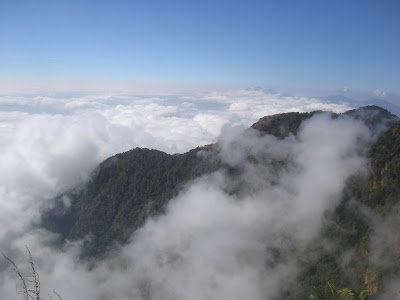Hill forests have been rapidly deteriorating due to human settlements and agricultural activities. Slash-and-burn, the common practice of cultivation in hill areas, has not only the deleterious effect on the biodiversity but it also results soil erosion and landslide.
There are few forest patches in the remote hill areas of Chitwan which are still intact. Dense forest around the Chisapani Tar (1695 m.) that stretches from Upardang Gadi (1275 m.) to Siraichuli (1973 m.), the pristine habitat, is especially known for its rich bird diversity.
Chisapani Tar
Many species of warbler, thrush, bulbul, drongo, sunbird, babbler, flycatcher, niltava, tit and tesia are commonly seen. Some of the hill birds that have been recorded by the bird watchers during the tours organized by Bird Education Society (BES) are: Silver-eared Mesia, Red-billed Leiothrix, Streak-breasted Scimitar Babbler, Scaly-breasted Wren Babbler, Fire-tailed Sunbird, White-tailed Nuthatch, Kashmir Nuthatch, Black-faced Laughingthrush, Chestnut-crowned Laughingthrush, Rufous-chinned Laughingthrush, Darjeeling Woodpecker, Scaly-bellied Woodpecker, Kalij Pheasant, Blue-throated Flycatcher, Dark-sided Flycatcher, Striated Bulbul, Mountain Bulbul, Lemon-rumped Warbler, Golden-spectacled Warbler, Whistler's Warbler, Aberrant Bush Warbler, Maroon Oriole, Fire-breasted Flowerpecker, Chestnut-headed Tesia, Mountain Imperial Pigeon and Speckled Wood Pigeon.
View from Chisapani Tar
BES has recorded many new species from this region for its Bird Checklist Chitwan. As these virgin forests are still unexplored and untouched, there are more chances to find new species for Chitwan. As these hills are close to lowland of the Chitwan Valley, many lowland birds are also found here.
Chisapani Tar forests
Vegetation is mainly dominated by chilaune (Schima wallichii), katus (Castanopsis indica) and rhododendron in this sub-tropical climate.
February to April is the best season for bird watching and mountain viewing as the sky is clear and temperature is mild. Bright red blossom of rhododendron flowers attract many beautiful birds.
Rhododendron forest
Bird watchers can descend from Jyandala to Upardang Gadi when they start the trek from Hugdi. When the trek starts from Shaktikhor, it would be better to visit Upardang Gadi first then start uphill walk to Jyandala to view sunrise in Siraichuli. In either route, that is about 5 hours of walking distance, you will go through this beautiful forests full of colorful birds.






No comments:
Post a Comment